Archaeologists 2015
The first excavation season involved a team of 13 archaeologists who were assigned to different fronts. The following is a short biography of each of the archaeologists of the project. In parentheses we indicated the seasons in which they participated.
Sarah Baitzel (2015)
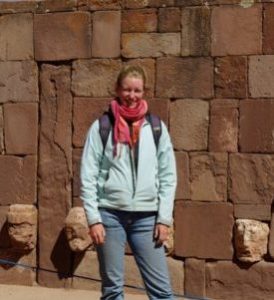
Sarah is an archaeologist specializing in mortuary archaeology in the pre-Columbian Andes. Since 2004, she has worked in various coastal desert sites in the southern and northern regions of Peru, excavating and analyzing burial contexts associated with the Tiwanaku (A.D. 500-1100) and other cultures. She received her B.A. in Anthropology from the University of California Santa Barbara and her M.A. and Ph.D. in Anthropology from the University of California San Diego. Her research interests include funerary rituals, material studies (especially textiles and ceramics), bioarchaeology, social identity, and Andean archaeology.
To gain a comparative perspective on the development of early states and urban societies in other regions of the Americas, she joined the Plaza of the Columns Project at Teotihuacan in 2015 where she came to appreciate the site of Teotihuacan for its rich history, culture, and cuisine of central Mexico.
Teresa Hsu (2015)
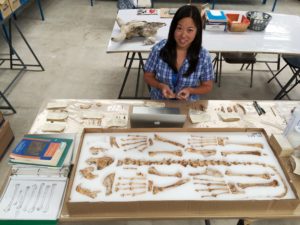
Teresa is manager for the Program in Human Ecology and Archaeobiology at the National Museum of Natural History, Smithsonian Institution. She received her Master’s degree in Osteoarchaeology at the University of Southampton, England, where she conducted research using ancient DNA from Pleistocene guanacos of South America. Besides her work on megafauna extinction of camelids and equids across the Western Hemisphere, she has experience in analyzing osteological material from archaeological sites in the Old World (e.g., Hallan Çemi in Turkey) and coastal sites in Hawaii, Alaska, Oregon, as well as Papua New Guinea. Her background and expertise continue to span across a number of disciplines including forensic anthropology, human skeletal biology, animal domestication, as well as comparative and functional morphology.
Teresa has worked with the Smithsonian Institution since 2011 on the organization, conservation, and management of the PHEA’s collections of modern, archaeological, and paleontological skeletal remains and artifacts. She joined the project in 2015, assisting with the excavations of Front C and initial management of artifact processing at Casa del Rio. With her background in conservation and osteology, she helped curate maxilla necklaces from previous excavations at Teotihuacan as well as processed skeletons for a new comparative osteological collection for the project.
Ángel Corona Muñoz (2015)
Ángel participated in the first season of the project in 2015 as an archaeologist in Front A.
Mariela Pérez Antonio (2015-2018)

Mariela received her degree in Archaeology from the Universidad Veracruzana with her thesis entitled “Public and Social Utility of Archaeological Research in Teotihuacan.” She has experience in various excavations, beginning with her 2011 fieldwork with the archaeological project Río de los Pescados in the central semiarid region of Veracruz. In 2012 she participated in the project El Sistema Urbano de la Ventilla in Teotihuacan and analyzed the materials from the archaeological project El Palmar: Urbanization of the Social Space in the Maya Lowlands at Campeche in Mexico. In the same year, she worked for the archaeological project Estero Rabón: Reconstructing the Life of the Olmecs, both in the excavation and analyses of the materials.
In 2015 she joined the excavation team at Teotihuacan and is currently analyzing the first season’s ceramic material.
Omar Rodríguez Campero (2015-2017)

As a graduate from the National School of Anthropology and History (ENAH), Omar holds twenty years of research experience in Mesoamerican cultures, particularly in the Mayan culture. He has served as field manager of various research projects at the archaeological sites of Calakmul, Balamku, and Dzibilnocac in Campeche, Mexico. He has also participated in a paleontological research project in Tocuila, Texcoco, in partnership with the Autonomous University of Chapingo and the Laboratory Branch and Academic Support of the National Institute of Anthropology and History (INAH), as well as with the Projects of Formative Research in the Mezquital Valley at the state of Hidalgo. From 2003 to 2006, he served as head of the ancient Mayan city of Calakmul, collaborating on the management, design, and implementation of signage at the site. Among his professional interests are architectural conservation, protection and dissemination of cultural heritage, and semiotics applied to historical disciplines.
Adriana Sánchez López (2015-2018)
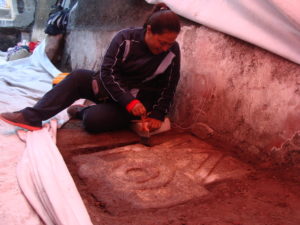
Adriana is an archaeologist from the National School of Anthropology and History (ENAH). Her thesis topic is a thematic interpretation on a specific area of Teotihuacan. She has worked in various projects in the historic center of Mexico City with the Archaeological Salvage Sub-Directorate (Subdirección de Salvamento Arqueológico, now Directorate), and her subsequent experience has led her to participate in the San Francisco River Project in the city of Puebla. She remained in the Mayan area for nearly 13 years, where she worked with several researchers and ultimately managed the archaeological research project “Tabasqueños,” a site in the Chenes region. There in Campeche, she devoted her extra time to a program implemented by the Center of National Institute of Anthropology and History (INAH), providing workshops for foster children and their guardians. Since March 2011, she has participated in several projects in Teotihuacan, including the conservation project “Quetzalpapalotl-Jaguares” and “Estructura I” of the Moon Plaza.
Ariel Texis Muñoz (2015-2016, 2018-2019, 2022-2023)
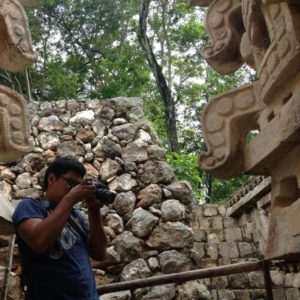
Ariel is a graduate archaeologist of the Universidad de las Américas Puebla (UDLAP) and was a thesis student of the Tlalancaleca Archaeological Project, Puebla. As a native to Tlaxcala, the smallest state in Mexico, it grew up under the influence of the Nahuatl culture that is still present in the villages of the region. For this reason, he aims to preserve his ancient heritage, both the tangible and intangible. He has worked in multiple archaeological sites such as: Tepeticpac (Tlaxcala), Yaxuná (Yucatán), archaeological salvages in Cholula. It was at Tlalancaleca (Puebla) where he carried out his research project “Tlalancaleca: ceramics and regional dynamics”.
Ariel was part of the first team to join the Project Plaza of the Columns, and he has participated during the 2015, 2016, and 2019 excavation seasons. In 2018 he joined the Surface Survey Team, being in charge of verify elements in the field. In addition, it has collaborated in the analysis of the LiDAR map of the Teotihuacan Valley in search of elements that are detected through this tool, to later confirm its existence through surface survey, as well as taking samples, such as ceramics or obsidian , which are regularly at ground level. He has been the person in contact with the communities, since all the surface part of the project has been carried out under the permission and supervision of each locality of the different municipalities of the Teotihuacan Valley.
Adriana Isabel Vera Martínez (2015)
Adriana Isabel participated in the first season of this project with Front A and excavated in the heart of the Plaza of the Columns as well as along the Avenue of the Dead (La Calzada de los Muertos).
Gabriel Vicencio Castellanos (2015)
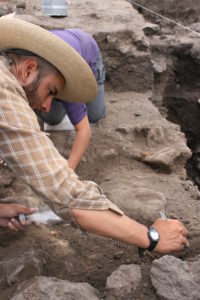
Gabriel Vicencio Castellanos is a recent archaeology graduate from the University of the Americas at Puebla. He began his fieldwork experience in 2008 with the Interaction Policy Project at the Center of Yucatan. During his three seasons with the project, he has had the opportunity to work on the site of Yaxuná as well as participate in other archaeological caving projects in central Yucatan. Several years later in 2012, Gabriel began to specialize in the analysis of obsidian, preparing his thesis “The Knives in Tepeticpac: Analysis of Obsidian in an Architectural Site in Tepeticpac, Tlaxcala.” In addition to his contributions to the tlaxcalteco project, he has helped support the mapping project of Teotihuacan, analyzed the obsidian material from a Teotihuacan workshop, and worked on the first season of excavation at the Plaza of the Columns Project.